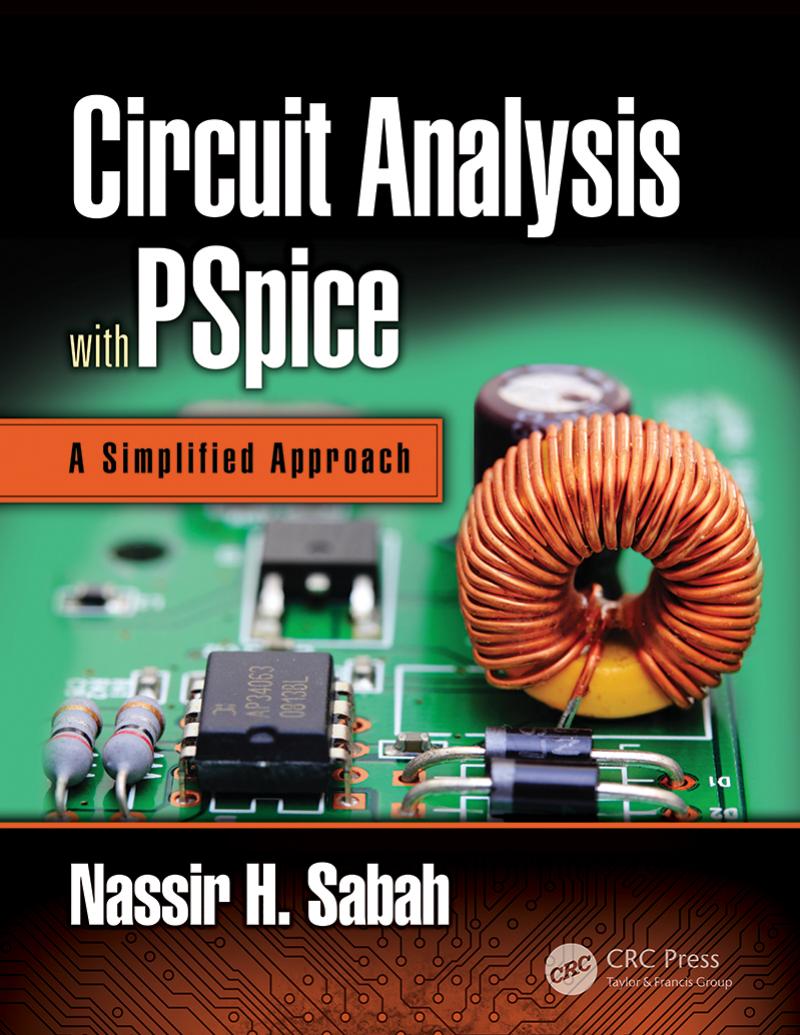Circuit Analysis with PSpice A Simplified Approach 1st Edition by Nassir Sabah ISBN 1315402203 9781315402208
$70.00 Original price was: $70.00.$35.00Current price is: $35.00.
Instant download Circuit Analysis with PSpice A Simplified Approach B0727N9MFB after payment
Circuit Analysis with PSpice: A Simplified Approach 1st Edition by Nassir H. Sabah – Ebook PDF Instant Download/Delivery: 1315402203, 978-1315402208
Full dowload Circuit Analysis with PSpice: A Simplified Approach 1st Edition after payment
Product details:
ISBN 10: 1315402203
ISBN 13: 978-1315402208
Author: Nassir H. Sabah
Circuit Analysis with PSpice: A Simplified Approach 1st Edition: Electric circuits, and their electronic circuit extensions, are found in all electrical and electronic equipment; including: household equipment, lighting, heating, air conditioning, control systems in both homes and commercial buildings, computers, consumer electronics, and means of transportation, such as cars, buses, trains, ships, and airplanes. Electric circuit analysis is essential for designing all these systems.
Electric circuit analysis is a foundation for all hardware courses taken by students in electrical engineering and allied fields, such as electronics, computer hardware, communications and control systems, and electric power. This book is intended to help students master basic electric circuit analysis, as an essential component of their professional education. Furthermore, the objective of this book is to approach circuit analysis by developing a sound understanding of fundamentals and a problem-solving methodology that encourages critical thinking.
Circuit Analysis with PSpice: A Simplified Approach 1st Edition Table of contents:
Part I: Basic Concepts in Circuit Analysis
Chapter 1: Preliminaries to Circuit Analysis
- 1.1 What Are Electric Circuits and What Are They Used For?
- 1.2 What Laws Govern the Behavior of Electric Circuits?
- 1.3 What Is Electric Current?
- 1.4 What Is the Direction of Current?
- 1.5 What Is Voltage?
- 1.6 What Is Voltage Polarity?
- 1.7 How Are Energy and Power Related to Voltage and Current?
- 1.8 What Are Ideal Circuit Elements and How Do They Handle Energy?
- 1.9 Why Resistance, Capacitance, and Inductance?
- 1.10 What Are the Approximations Implicit in Basic Electric Circuits?
Chapter 2: Fundamentals of Resistive Circuits
- 2.1 Nature of Resistance
- 2.2 Ideal Resistor
- 2.3 Short Circuit and Open Circuit
- 2.4 Ideal, Independent Voltage Source
- 2.5 Ideal, Independent Current Source
- 2.6 Ideal, Dependent Sources
- 2.7 Nomenclature and Analysis of Resistive Circuits
- 2.8 Kirchhoff’s Laws
- 2.9 Series and Parallel Connections
Chapter 3: Circuit Equivalence
- 3.1 Circuit Equivalence and Its Implications
- 3.2 Series and Parallel Connection of Resistors
- 3.3 Resistivity
- 3.4 Star–Delta Transformation
- 3.5 Series and Parallel Connections of Ideal Sources
- 3.6 Linear-Output Sources
Chapter 4: Circuit Theorems
- 4.1 Excitation by Dependent Sources
- 4.2 Thevenin’s Theorem
- 4.3 Norton’s Theorem
- 4.4 Substitution Theorem
- 4.5 Source Absorption Theorem
Chapter 5: Circuit Simplification
- 5.1 Superposition
- 5.2 Output Scaling
- 5.3 Redundant Resistors
- 5.4 Partitioning of Circuits by Ideal Sources
- 5.5 Source Rearrangement
- 5.6 Exploitation of Symmetry
Chapter 6: Circuit Equations
- 6.1 Node-Voltage Method
- 6.2 Mesh-Current Method
- 6.3 Dependent Sources in Mesh-Current Method
Chapter 7: Capacitors, Inductors, and Duality
- 7.1 Voltage–Current Relation of a Capacitor
- 7.2 Voltage–Current Relation of an Inductor
- 7.3 Series and Parallel Connections of Initially Uncharged Capacitors
- 7.4 Series and Parallel Connections of Initially Uncharged Inductors
- 7.5 Duality
Chapter 8: Sinusoidal Steady State
- 8.1 The Sinusoidal Function
- 8.2 Responses to Sinusoidal Excitation
- 8.3 Phasors
- 8.4 Phasor Relations of Circuit Elements
- 8.5 Impedance and Reactance
- 8.6 Governing Equations
- 8.7 Representation in the Frequency Domain
- 8.8 Phasor Diagrams
Chapter 9: Linear Transformer
- 9.1 Magnetic Coupling
- 9.2 Mutual Inductance
- 9.3 Linear Transformer
- 9.4 T-Equivalent Circuit
Chapter 10: Ideal Transformers
- 10.1 Magnetic Circuit
- 10.2 Ideal Transformer
- 10.3 Reflection of Circuits
- 10.4 Ideal Autotransformer
- 10.5 Transformer Imperfections
Chapter 11: Basic Responses of First-Order Circuits
- 11.1 Capacitor Discharge
- 11.2 Capacitor Charging
- 11.3 Inductor Discharge
- 11.4 Inductor Charging
- 11.5 Generalized First-Order Circuits
- 11.6 Role of Transient
Chapter 12: Basic Responses of Second-Order Circuits
- 12.1 Natural Responses of Series RLC Circuit
- 12.2 Natural Response of Parallel GCL Circuit
- 12.3 Charging of Series RLC Circuit
- 12.4 Procedure for Analyzing Prototypical Second-Order Circuits
Part II: Topics in Circuit Analysis
13. Ideal Operational Amplifier
- 13.1 Basic Properties
- 13.2 Feedback
- 13.3 Noninverting Configuration
- 13.4 Inverting Configuration
- 13.5 Applications of the Inverting Configuration
- 13.6 Difference Amplifier
- 13.7 Solving Problems on Operational Amplifiers
14. Frequency Responses
- 14.1 Analysis of Filters
- 14.2 Ideal Frequency Responses
- 14.3 First-Order Responses
- 14.4 Bode Plots
- 14.5 Second-Order Bandpass Response
- 14.6 Second-Order Bandstop Response
- 14.7 Second-Order Low-Pass and High-Pass Responses
- 14.8 Parallel Circuit
- 14.9 Summary of Second-Order Responses
15. Butterworth and Active Filters
- 15.1 Scaling
- 15.2 Butterworth Response
- 15.3 First-Order Active Filters
- 15.4 Noninverting Second-Order Active Filters
- 15.5 Inverting Second-Order Active Filters
- 15.6 Universal Filter
16. Responses to Periodic Inputs
- 16.1 Fourier Series
- 16.2 Fourier Analysis
- 16.3 Symmetry Properties of Fourier Series
- 16.4 Derivation of FSEs from Other Functions
- 16.5 Concluding Remarks on FSEs
- 16.6 Circuit Responses to Periodic Functions
- 16.7 Average Power and rms Values
17. Real, Reactive, and Complex Power
- 17.1 Instantaneous and Real Power
- 17.2 Complex Power
- 17.3 Power Factor Correction
- 17.4 Maximum Power Transfer
18. Responses to Step and Impulse Inputs
- 18.1 Capacitor Response to Current Pulse
- 18.2 The Impulse Function
- 18.3 Responses of Capacitive Circuits
- 18.4 Inductor Response to Voltage Pulse
- 18.5 Responses of Inductive Circuits
- 18.6 Responses of RLC Circuits
19. Switched Circuits with Initial Energy Storage
- 19.1 Series and Parallel Connections of Capacitors
- 19.2 Series and Parallel Connections of Inductors
- 19.3 Switched Circuits
20. Convolution
- 20.1 Shifting in Time and Folding
- 20.2 Convolution Integral
- 20.3 Operational Properties of Convolution
- 20.4 Special Cases of Convolution
- 20.5 General Properties of Convolution
21. Properties of the Laplace Transform
- 21.1 General
- 21.2 Operational Properties of the Laplace Transform
- 21.3 Solution of Linear, Ordinary Differential Equations
- 21.4 Theorems on the Laplace Transform
22. Laplace Transform in Circuit Analysis
- 22.1 Representation of Circuit Elements
- 22.2 Solution of Circuit Problems in the s-Domain
- 22.3 Transfer Function
- 22.4 Interpretations of Circuit Responses
23. Fourier Transform
- 23.1 Derivation of the Fourier Transform
- 23.2 General Properties of the Fourier Transform
- 23.3 Operational Properties of the Fourier Transform
- 23.4 Circuit Applications of the Fourier Transform
- 23.5 Parseval’s Theorem
24. Two-Port Circuits
- 24.1 Circuit Description
- 24.2 Parameter Interpretation and Relations
- 24.3 Equivalent Circuits
- 24.4 Composite Two-Port Circuits
- 24.5 Analysis of Terminated Two-Port Circuits
25. Balanced Three-Phase Systems
- 25.1 Three-Phase Variables
- 25.2 The Balanced Y Connection
- 25.3 The Balanced γ Connection
- 25.4 Analysis of Balanced Three-Phase Systems
- 25.5 Power in Balanced Three-Phase Systems
- 25.6 Advantages of Three-Phase Systems
- 25.7 Power Generation, Transmission, and Distribution
People also search for Circuit Analysis with PSpice: A Simplified Approach 1st Edition:
circuit analysis examples
circuit analysis techniques
simple circuit analysis problems
pspice analysis
spice circuit analysis



